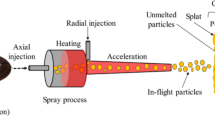Abstract
In this work, a conventional tungsten carbide 12% cobalt (WC-12Co) coating was deposited by using a liquid fuel JP-8000 high velocity oxyfuel spray system. The properties of the coating namely phase content, microstructure, hardness, porosity, and fracture toughness were examined. The microstructure evolution and its influence on the abrasive wear behavior of the coatings were evaluated in detail by in-situ scanning electron microscopy and a comprehensive model for decarburization of WC has been established using x-ray diffraction and transmission electron microscopy analyses.









Similar content being viewed by others
References
Q. Wang, Z.X. Tang, and L.M. Cha, Cavitation and sand slurry erosion resistances of WC-10Co-4Cr coatings, J. Mater. Eng. Perform., 2015, 24, p 2435–2443
M.S. Han, S.J. Lee, M.S. Kim, S.K. Jang, and S.J. Kim, Electrochemical characteristics of HVOF spray coated layer with WC − 27NiCr and WC − 10Co4Cr for Al bronze, Trans. Nonferrous Met. Soc. China, 2012, 22, p s753–s759
C.J. Li and G.J. Yang, Relationships between feedstock structure, particle parameter, coating deposition, microstructure and properties for thermally sprayed conventional and nanostructured WC-Co, Int. J. Refract. Met. Hard Mater., 2013, 39, p 2–17
Z.X. Ding, W. Chen, and Q. Wang, Resistance of cavitation erosion of multimodal WC-12Co coatings sprayed by HVOF, Trans. Nonferrous Met. Soc. China, 2011, 21, p 129–135
M.E. Vinayo, F. Kassabji, J. Guyonnet, and P. Fauchais, Plasma sprayed WC-Co coatings: influence of spray conditions (atmospheric and low pressure plasma spraying) on the crystal structure, porosity, and hardness, J. Vac. Sci. Technol. A, 1985, 3, p 2483–2489
H. Liao, B. Normand, and C. Coddet, Influence of coating microstructure on the abrasive wear resistance of WC/Co cermet coatings, Surf. Coat. Technol., 2000, 124, p 235–245
B.H. Kear, G. Skandan, and R.K. Sadangi, Factors controlling decarburization in HVOF sprayed nano-WC/Co hardcoatings, Scripta Mater., 2001, 44, p 1703–1707
R. Ahmed, O. Ali, N.H. Faisal, N.M. Al-Anazi, S. Al-Mutairi, F.-L. Toma, L.-M. Berger, A. Potthoff, and M.F.A. Goosen, Sliding wear investigation of suspension sprayed WC-Co nanocomposite coatings, Wear, 2015, 322–323, p 133–150
Q. Wang, J. Xiang, G.Y. Chen, Y.L. Cheng, X.Q. Zhao, and S.Q. Zhang, Propylene flow, microstructure and performance of WC-12Co coatings using a gas-fuel HVOF spray process[J], J. Mater. Process. Technol., 2013, 213, p 1653–1660
M.A. Rodríguez, L. Gil, S. Camero, N. Fréty, Y. Santana, and J. Caro, Effects of the dispersion time on the microstructure and wear resistance of WC/Co-CNTs HVOF sprayed coatings, Surf. Coat. Technol., 2014, 258, p 38–48
L. Jacobs, M.M. Hyland, and M.D. Bonte, Study of the influence of microstructural properties on the sliding-wear behavior of HVOF and HVAF sprayed WC-cermet coatings, J. Therm. Spray Technol., 1999, 8, p 125–132
C. Lyphout and K. Sato, Screening design of hard metal feedstock powders for supersonic air fuel processing, Surf. Coat. Technol., 2014, 258, p 447–457
J.A. Picas, M. Punset, M.T. Baile, E. Martín, and A. Forn, Effect of oxygen/fuel ratio on the in-flight particle parameters and properties of HVOF WC-CoCr coatings, Surf. Coat. Technol., 2011, 205, p s364–s368
Q. Wang, Z.H. Chen, L.X. Li, and G.B. Yang, The parameters optimization and abrasion wear mechanism of liquid fuel HVOF sprayed bimodal WC-12Co coating, Surf. Coat. Technol., 2012, 206, p 2233–2241
D.A. Stewart, P.H. Shipway, and D.G. Mccartney, Microstructural evolution in thermally sprayed WC-Co coatings: comparison between nanocomposite and conventional starting powders, Acta Mater., 2000, 48, p 1593–1604
B. Cecilia, V. Teodoro, C. Fabio, B. Edoardo, and T. Mario, Parametric study of an HVOF process for the deposition of nanostructured WC-Co coatings, J. Therm. Spray Technol., 2005, 14, p 187–195
B. Giovanni, C. Valeria, L. Luca, and R. Sara, Mechanical and tribological properties of electrolytic hard chrome and HVOF-sprayed coatings, Surf. Coat. Technol., 2006, 200, p 2995–3009
Author information
Authors and Affiliations
Corresponding author
Rights and permissions
About this article
Cite this article
Fu, D., Xiong, H. & Wang, Q. Microstructure Evolution and Its Effect on the Wear Performance of HVOF-Sprayed Conventional WC-Co Coating. J. of Materi Eng and Perform 25, 4352–4358 (2016). https://doi.org/10.1007/s11665-016-2278-y
Received:
Revised:
Published:
Issue Date:
DOI: https://doi.org/10.1007/s11665-016-2278-y




